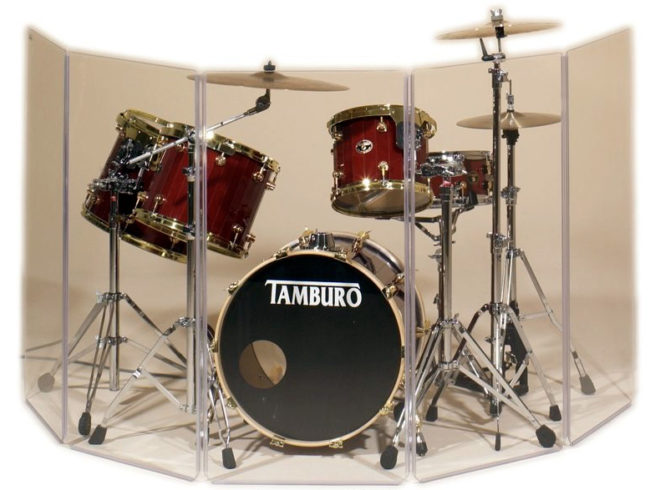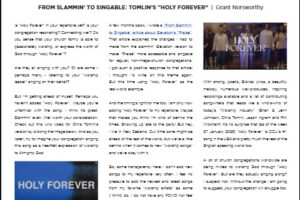Are we hoping to enthrall the viewing audience with a concert-like musical performance? Or are…

DRUM VOLUME PROBLEMS: THE CASE AGAINST SHIELDS & ENCLOSURES
By Grant Norsworthy
My parents always told me, “Just because everyone’s doing it, doesn’t make it right!” That wisdom rings true with how to solve drum volume problems too!
Problem: The drums are just too loud! The acoustic sound of the drums is overpowering the front of house mix! Bleeding into the vocal mics! Driving other band members’ monitor levels up! Drawing complaints from congregation members … and the senior pastor!
That’s way too many exclamation points for a single paragraph, I know. But I wanted to make clear that I get it. Out-of-control drum levels – especially from cymbals and snare – are a HUGE and common problem in church audio. But, in my opinion, the most common solutions – the things that (just about) everyone is doing to “solve” the problem – are NOT the best solutions.
Conventional, widely-accepted “solutions” include spending big money on plexiglass drum walls, sound absorption panels, sound proofed (hopefully ventilated) enclosures or (worst of all) electronic drums.
In many cases – with these more common attempts applied – the problem of the drums being too loud is only reduced and not solved. And the source of the problem has only received a “Band-Aid” treatment. The REAL problem (the drummer’s playing too loud!) has not actually been addressed at all.
There are those who claim that the “fish tank” drum enclosure or the electronic kit has completely solved the problem. But at what cost? Maybe the audio engineer is happy, but we may have simply exchanged one set of problems for others. The mix might be more in control, but are the musicians and congregation really engaged? Catching the vibe? Singing? Are they fully experiencing the level of horizontal and vertical connection that is our MAIN objective?
For the most part, the people in the congregation don’t understand what’s going on with keyboards, guitars and mixing consoles. But everyone has at least some connection with two elements of what we’re presenting: the human voice and the drums. It is my firm belief that church congregations – regular people – are MOST warmly invited to sing worshipfully to God by way of the fundamental, primal musicality of singing and – “hit stuff make noises” – the drums.
If connection is our goal – and the drums are one of our most valuable assets to bring it about – more serious consideration ought to be given before we build physical barriers around, or resort to synthetic version of the drums. Barriers are built to isolate. But we’re all about using music to achieve connection, right?
So, before you take the well-worn path of “Every other church is doing it, so it must be what’s right for us”, PLEASE try, or at least consider these steps to a better solution:
- Drummers MUST have dynamic control.
The problem is NOT that we don’t have drum shields. The problem is that the drums are too loud. The drums are too loud because the drummer is hitting them with too much force! Many drummers have never been taught – or never learned – dynamic control. Yet, using dynamics well is a prerequisite for musicality. The fastest way to ensure a drummer never learns dynamic control is to put them on an electronic kit, or in an enclosure. Drummers must “play the room”! When they strike a drum or cymbal, they must recognize they are activating every air molecule and utilizing every surface in the room that they are in. They must see the whole room as their instrument and play the drums accordingly and with appropriate volume. - Clearly Communicated Expectations.
The musical director (MD) MUST be ready to make the essential requirement of dynamic control known to the drummer. Well informed by the audio engineer, they must exercise their authority to direct in this way. If the drums are too loud, maybe hot rods are needed. Brushes? A djembe? Be ready to help your drummer learn to “play the room” at appropriate volume levels. Altering the hardware until they learn, can sometimes be the only way forward. After all, the drummer playing the drums “their way” is NOT our highest priority. Crafting a sound in the room that helps people sing prayers to God and reminders of God’s truth to each other is the objective. - Resist Hit Single Replication.
Recognize that in our local church setting we are NOT trying to copy every detail of a song that was recorded live by Hillsong in front of 20,000 people or in a pro Nashville recording studio, using every trick available to produce a slammin’, arena-pop anthem for the masses. The massive sound of pounding drums and cymbals being beaten within an inch of their life might work great in those setting. But not for us! The intensity of the drum playing needs to be right for our room, our songs, our people and our version of the song. That invariably means LESS! - Position of the Drum Kit.
Where is the drum kit in relation to other microphones? It’s always a good idea to keep any vocal microphones as far away from the drum kit as possible. Ideally, I like to have the drum kit far off to one side or other of the platform and angled slightly towards the center with the leading vocalist in the center. If there is a line of singers on the platform, have them positioned on the opposite side from the drums. This will greatly reduce drum “spill” in unwanted places. - Inappropriate Drum/Cymbal Choice.
Most drum kits made since Led Zeppelin’s John Bonham hit the scene in the 70’s have been made to be hit hard and loud. But drums don’t have to be like that. There are alternatives! What type of drums and cymbals are you using? The reason why some drummers find it so difficult to play more quietly is because the drums they’re playing are made to “sing” only when they are hit hard. Cheaper kits especially, choke when played more gently. Hitting them hard can disguise the uninspiring, poor quality of their sound. Higher quality, smaller diameter, thinner shelled drums, matched with “darker” more mellow cymbals should be used in church settings. I’m a fan of Adoro’s “worship series” drums for great sound at lower playing intensity. - Cymbal Shields.
When the acoustic sound of drums is too loud, it’s actually the higher frequencies that become offensive first. Principally that’s the cymbals and the top “crack” of the snare. Instead of shielding or enclosing the whole kit, consider shielding just the cymbals. Without isolating the drummer, the most troublesome frequencies of the kit can be reduced with far smaller pieces of plexiglass in just the right positions. Check out this YouTube video by Harald Rubens (Steven Curtis Chapman’s audio engineer) explaining and demoing the benefits.
Having drums behind walls, inside a “fish tank” or from electronic pads with “fake”, synthetic sounds always sucks away the “vibe” and makes it more difficult for true connection to occur. Let’s hold onto, or bring back, the joy of sharing the same vibrating air with acoustic drums – but at the right volume level!
My tongue is only partially in my cheek, as I quote a Bible verse to finish this article:
The Lord is my strength and my shield;
in him my heart trusts, and I am helped;
my heart exults, and with my song I give thanks to him.
Psalm 28:7 (ESV)
See! The Bible tells us that God is our shield. Surely it follows that we don’t need another shield made of plexiglass!
For more info on this topic, click these video links:
Video #1: Solving Drum Volume Issues: Without a “Fish Tank”
Video #2: Solving Drum Volume Issues: Dynamic Control
This article was first published by Worship Tech Director of the WFX Network on Oct 05, 2018.


